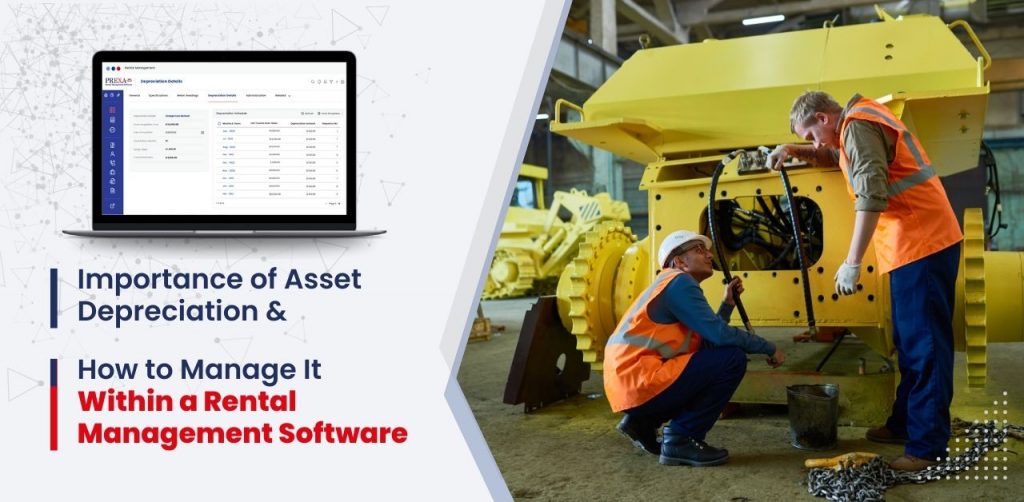Importance of Asset Depreciation and How to Manage It Within a Rental Management Software

Effective rental management goes beyond leasing. It requires tracking depreciation to set competitive rates, optimize the values of your assets, and maximize profitability. A robust rental management solution simplifies this by automating depreciation calculation and helping to track assets properly. But before we take a deep dive, let’s see what it is and how do we calculate it.
What is Depreciation?
Depreciation refers to the gradual reduction in the value of an asset due to wear and tear, age, or obsolescence. For example, if a rental company purchases an asset, it’s worth will naturally decline over time due to frequent use and market changes. This loss in value is considered depreciation, and calculating it correctly allows businesses to assess the true cost of asset ownership.
More than just an accounting metric, depreciation is a financial strategy that helps rental business owners manage costs effectively while maximizing profitability.
Common Depreciation Methods
There are several ways to calculate depreciation, and the choice of method depends on the nature of the asset and business requirements. Below are the most commonly used approaches:
1. Straight-Line Depreciation
This method evenly distributes the depreciation amount over the asset’s useful life. It is the simplest and most widely used depreciation technique.
Example:
If a forklift is purchased for $50,000, expected to last 10 years, with a salvage value of $5,000:
This means $4,500 is recorded as depreciation each year.
2. Declining Balance Depreciation
This accelerated method applies a higher depreciation expense in the earlier years of an asset’s life. It is beneficial for businesses dealing with assets that lose value more rapidly, such as technology-intensive machinery.
- Double-Declining Balance: Depreciates at twice the straight-line rate, allowing businesses to write off a larger portion of the asset’s cost early on.
3. Units of Production Depreciation
Unlike the previous methods, this approach bases depreciation on actual usage rather than time. This is ideal for assets that have variable usage rates.
Multiply this rate by the actual number of units produced or hours used in each period.
How to Calculate Depreciation: A Practical Example
Let’s consider an example to illustrate the depreciation process.
A backhoe loader is purchased for $75,000, expected to last 10 years, with an estimated salvage value of $10,000. Using the straight-line method, the calculations would be:
Thus, $6,500 is recorded annually as depreciation.
Why Should You Track Asset Depreciation for Your Rental Business
Depreciation has a significant financial impact on rental businesses. For example, Hertz Global Holdings recorded a $1 billion asset impairment charge and an 89% increase in depreciation expenses, underscoring its effect on profitability.
Proper depreciation tracking helps rental businesses in key areas:
- Optimizing Rental Pricing – Factoring in depreciation ensures rental rates cover asset devaluation and operational costs, maintaining profitability while staying competitive.
- Strategic Asset Planning – Depreciation data helps rental businesses forecast asset replacement cycles, avoiding unexpected downtime and costly repairs.
- Maximizing ROI – If rental revenue doesn’t offset depreciation and maintenance costs, businesses must adjust pricing, utilization, or asset investments for long-term profitability.
The Role of a Rental Management Software in Asset Depreciation Tracking
Managing asset depreciation effectively is crucial for rental businesses to set competitive pricing, optimize asset utilization, and enhance financial planning. Rental management software simplifies this process by automating depreciation tracking, reducing manual errors, and providing real-time financial insights.
Here is how it transforms the way you manage depreciation:
- Automated and Accurate Depreciation Tracking
- Real-Time Asset Valuation & Pricing Insights
- Optimized Asset Lifecycle Planning
- Tax & ROI Optimization
Depreciation is not just an accounting necessity—it’s a strategic financial tool that enables rental businesses to maintain profitability, extend asset lifespans, and drive informed decision-making.
By adopting a robust management system, businesses can gain automated, data-driven insights that improve pricing strategies, asset management, and this ensures sustainable growth and maximum profitability.






